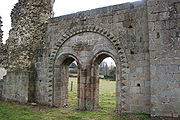
Savigny Abbey
Encyclopedia

Savigny-le-Vieux
Savigny-le-Vieux is a commune in the Manche department in Normandy in north-western France.-See also:*Savigny Abbey*Communes of the Manche department...
(Manche
Manche
Manche is a French department in Normandy named after La Manche , which is the French name for the English Channel.- History :Manche is one of the original 83 departments created during the French Revolution on March 4, 1790...
), in northern France. It was founded early in the 12th century. Initially it was the central house of the Congregation of Savigny
Congregation of Savigny
The monastic Congregation of Savigny started in the abbey of Savigny, situated in northern France, on the confines of Normandy and Brittany, in the Diocese of Coutances. It originated in 1105 when Vitalis of Mortain established a hermitage in the forest at Savigny in France.-Founding:Vitalis was a...
, who were Benedictines; by 1150 it was Cistercian.
History
It was situated on the confines of NormandyNormandy
Normandy is a geographical region corresponding to the former Duchy of Normandy. It is in France.The continental territory covers 30,627 km² and forms the preponderant part of Normandy and roughly 5% of the territory of France. It is divided for administrative purposes into two régions:...
and Brittany
Brittany
Brittany is a cultural and administrative region in the north-west of France. Previously a kingdom and then a duchy, Brittany was united to the Kingdom of France in 1532 as a province. Brittany has also been referred to as Less, Lesser or Little Britain...
. The founder was Vital de Mortain, who set up a hermitage in the forest of Savigny (1105).
Rudolph, lord of Fougeres, confirmed to the monastery (1112) the grants he had formerly made to Vital, and from then dates the foundation of the monastery. Its growth was rapid, and Vital and Saint Aymon were canonized. It had 33 subordinate houses, within thirty years.
Have been canonized
- Vitalis of Savigny;
- Godfrey of AmiensGodfrey of AmiensGodfrey of Amiens was a bishop of Amiens. He is a saint in the Catholic Church.- Life :Godfrey was born in 1066 in Moulincourt, in the diocese of Soissons...
; - Saint Peter of AvranchesSaint PeterSaint Peter or Simon Peter was an early Christian leader, who is featured prominently in the New Testament Gospels and the Acts of the Apostles. The son of John or of Jonah and from the village of Bethsaida in the province of Galilee, his brother Andrew was also an apostle...
; - Saint WilliamSaint William-Saints:* Saint William of Æbelhot - French ecclesiastic active in Denmark...
; - Saint Aymon;
In 1119 Pope Celestine II
Pope Celestine II
Pope Celestine II , born Guido di Castello, was pope from 1143 to 1144.-Early life:Guido di Castello, possibly the son of a local noble, Niccolo di Castello, was born either in Città di Castello, situated in Paterna Santa Felicita upon the Apennines, or at Macerata in the March of Ancona.Guido had...
, then in Angers
Angers
Angers is the main city in the Maine-et-Loire department in western France about south-west of Paris. Angers is located in the French region known by its pre-revolutionary, provincial name, Anjou, and its inhabitants are called Angevins....
, took it under his immediate protection, and strongly commended it to the neighbouring nobles. Under Geoffroy, successor to Vital, Henry I of England
Henry I of England
Henry I was the fourth son of William I of England. He succeeded his elder brother William II as King of England in 1100 and defeated his eldest brother, Robert Curthose, to become Duke of Normandy in 1106...
established and generously endowed 29 monasteries of this Congregation in his dominions. Bernard of Clairvaux
Bernard of Clairvaux
Bernard of Clairvaux, O.Cist was a French abbot and the primary builder of the reforming Cistercian order.After the death of his mother, Bernard sought admission into the Cistercian order. Three years later, he was sent to found a new abbey at an isolated clearing in a glen known as the Val...
also held them in high esteem, and it was at his request that their monks, in the times of the antipope Anacletus, declared in favour of Pope Innocent II
Pope Innocent II
Pope Innocent II , born Gregorio Papareschi, was pope from 1130 to 1143, and was probably one of the clergy in personal attendance on the antipope Clement III .-Early years:...
.
Serlon, third successor of the Founder, found it difficult to retain his jurisdiction over the English monasteries, who wished to make themselves independent, and so determined to affiliate the entire Congregation to Citeaux, which was effected at the General Chapter of 1147. Several English monasteries objecting to this, were finally obliged to submit by Pope Eugene III
Pope Eugene III
Pope Blessed Eugene III , born Bernardo da Pisa, was Pope from 1145 to 1153. He was the first Cistercian to become Pope.-Early life:...
(1148).
In later centuries discipline became relaxed. In the mid-16th century the Abbey was pillaged and partly burned by Calvinists, and records of the following year mention but twenty-four monks remaining.
It continued to exist until the Revolution reduced it to a heap of ruins, and scattered its then existing members. The church was restored in 1869.
The abbey has been listed as a Monument historique
Monument historique
A monument historique is a National Heritage Site of France. It also refers to a state procedure in France by which national heritage protection is extended to a building or a specific part of a building, a collection of buildings, or gardens, bridges, and other structures, because of their...
by the French Ministry of Culture in 1924.
External links
- French Ministry of Culture: Abbey of Savigny
- L’abbaye de Savigny renaît peu à peu, in La Manche libre

